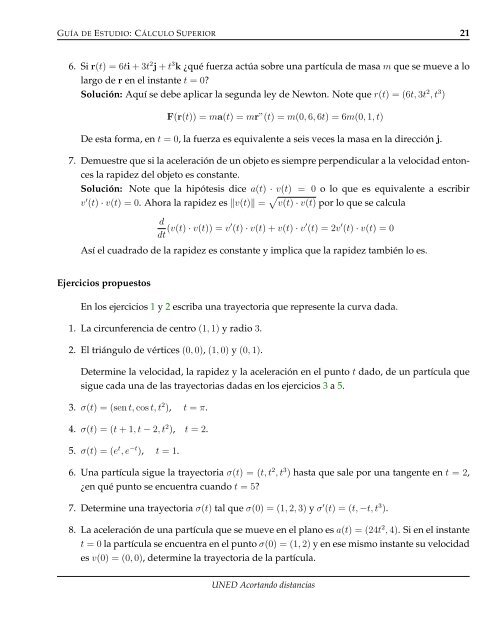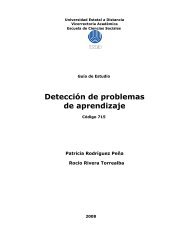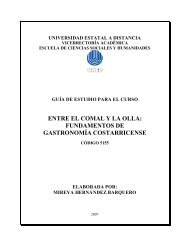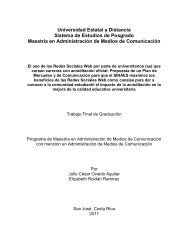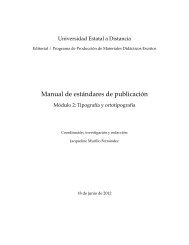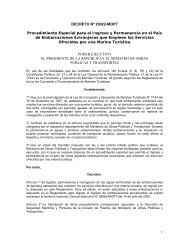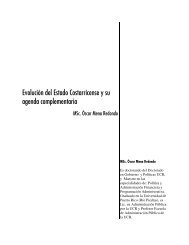GE3011 Cálculo Superior - Repositorio de la Universidad Estatal a ...
GE3011 Cálculo Superior - Repositorio de la Universidad Estatal a ...
GE3011 Cálculo Superior - Repositorio de la Universidad Estatal a ...
You also want an ePaper? Increase the reach of your titles
YUMPU automatically turns print PDFs into web optimized ePapers that Google loves.
GUÍA DE ESTUDIO: CÁLCULO SUPERIOR 21<br />
6. Si r(t) = 6ti + 3t 2 j + t 3 k ¿qué fuerza actúa sobre una partícu<strong>la</strong> <strong>de</strong> masa m que se mueve a lo<br />
<strong>la</strong>rgo <strong>de</strong> r en el instante t = 0?<br />
Solución: Aquí se <strong>de</strong>be aplicar <strong>la</strong> segunda ley <strong>de</strong> Newton. Note que r(t) = (6t, 3t 2 , t 3 )<br />
F(r(t)) = ma(t) = mr”(t) = m(0, 6, 6t) = 6m(0, 1, t)<br />
De esta forma, en t = 0, <strong>la</strong> fuerza es equivalente a seis veces <strong>la</strong> masa en <strong>la</strong> dirección j.<br />
7. Demuestre que si <strong>la</strong> aceleración <strong>de</strong> un objeto es siempre perpendicu<strong>la</strong>r a <strong>la</strong> velocidad enton-<br />
ces <strong>la</strong> rapi<strong>de</strong>z <strong>de</strong>l objeto es constante.<br />
Solución: Note que <strong>la</strong> hipótesis dice a(t) · v(t) = 0 o lo que es equivalente a escribir<br />
v ′ (t) · v(t) = 0. Ahora <strong>la</strong> rapi<strong>de</strong>z es v(t) = v(t) · v(t) por lo que se calcu<strong>la</strong><br />
d<br />
dt (v(t) · v(t)) = v′ (t) · v(t) + v(t) · v ′ (t) = 2v ′ (t) · v(t) = 0<br />
Así el cuadrado <strong>de</strong> <strong>la</strong> rapi<strong>de</strong>z es constante y implica que <strong>la</strong> rapi<strong>de</strong>z también lo es.<br />
Ejercicios propuestos<br />
En los ejercicios 1 y 2 escriba una trayectoria que represente <strong>la</strong> curva dada.<br />
1. La circunferencia <strong>de</strong> centro (1, 1) y radio 3.<br />
2. El triángulo <strong>de</strong> vértices (0, 0), (1, 0) y (0, 1).<br />
Determine <strong>la</strong> velocidad, <strong>la</strong> rapi<strong>de</strong>z y <strong>la</strong> aceleración en el punto t dado, <strong>de</strong> un partícu<strong>la</strong> que<br />
sigue cada una <strong>de</strong> <strong>la</strong>s trayectorias dadas en los ejercicios 3 a 5.<br />
3. σ(t) = (sen t, cos t, t 2 ), t = π.<br />
4. σ(t) = (t + 1, t − 2, t 2 ), t = 2.<br />
5. σ(t) = (e t , e −t ), t = 1.<br />
6. Una partícu<strong>la</strong> sigue <strong>la</strong> trayectoria σ(t) = (t, t 2 , t 3 ) hasta que sale por una tangente en t = 2,<br />
¿en qué punto se encuentra cuando t = 5?<br />
7. Determine una trayectoria σ(t) tal que σ(0) = (1, 2, 3) y σ ′ (t) = (t, −t, t 3 ).<br />
8. La aceleración <strong>de</strong> una partícu<strong>la</strong> que se mueve en el p<strong>la</strong>no es a(t) = (24t 2 , 4). Si en el instante<br />
t = 0 <strong>la</strong> partícu<strong>la</strong> se encuentra en el punto σ(0) = (1, 2) y en ese mismo instante su velocidad<br />
es v(0) = (0, 0), <strong>de</strong>termine <strong>la</strong> trayectoria <strong>de</strong> <strong>la</strong> partícu<strong>la</strong>.<br />
UNED Acortando distancias


